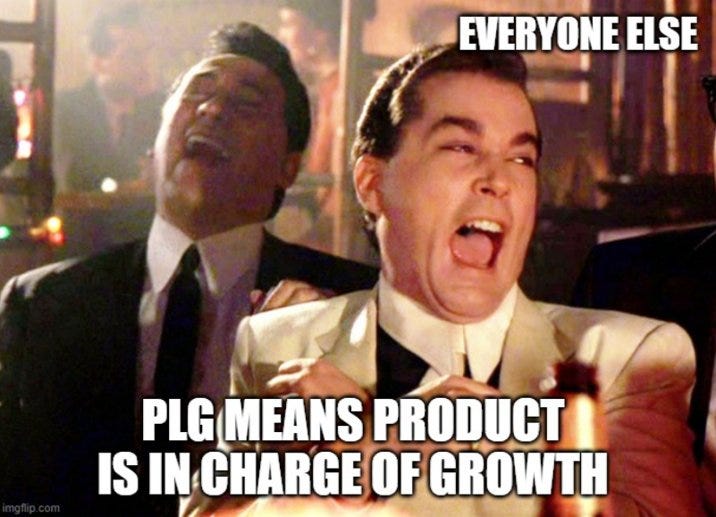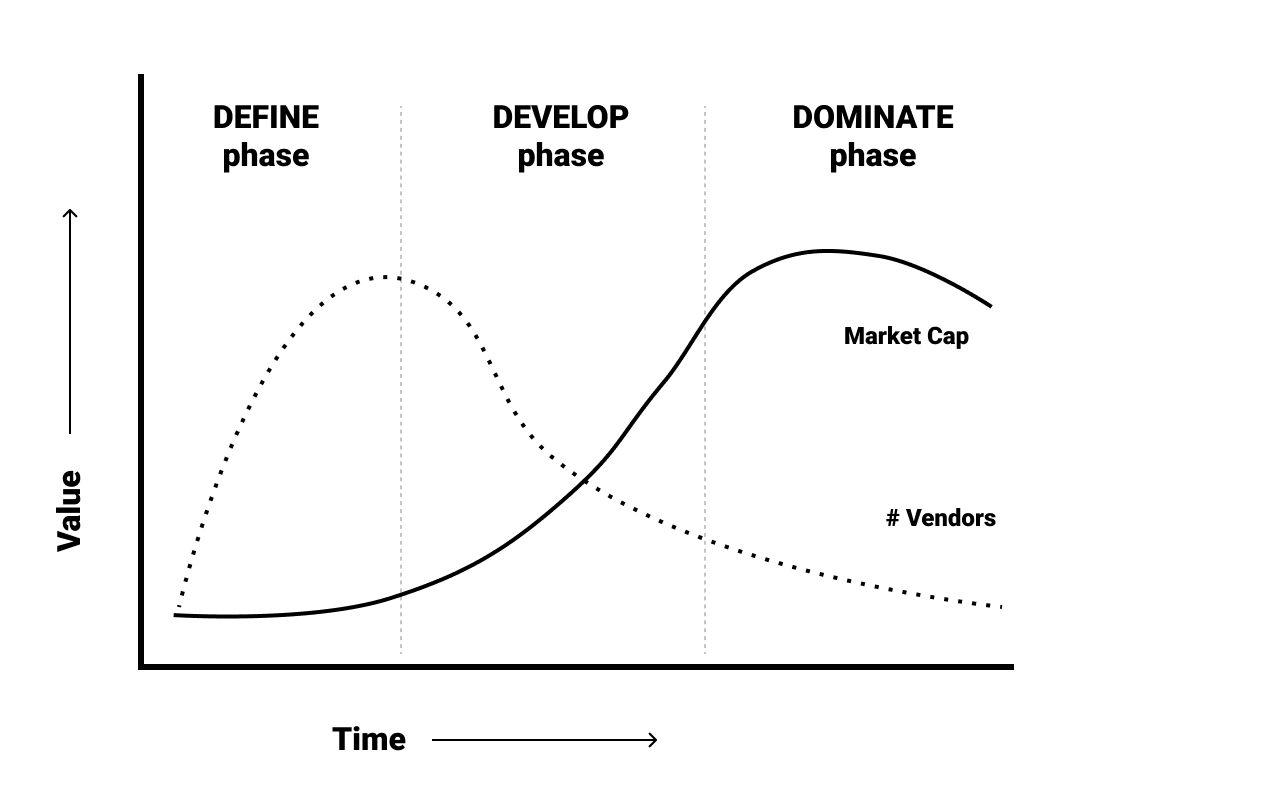Thank you for being part of this newsletter. Each week, I share playbooks, case studies, stories, and links from inside the startup marketing world. You can click the heart button 💙 above or below to share some love. And you can reach out to me anytime at hello@kevanlee.com. I’d love to hear from you.
Links that are worth your time:
Who owns growth at a Product-Led Growth company? (Hint: It’s not necessarily product.)
I’m very grateful to have been included in this essay, and I love the featured image:
Hi there 👋
When I was at Buffer, there were a handful of fellow SaaS companies that we held in high esteem. Basecamp was one of them. So I’ve found myself rather glued to the Basecamp news this week and all the fallout that has ensued. In a lot of ways, it is a good reminder to me that I can never really know what life is like inside another company; I needn’t feel envious or covetous of what I see from the outside because there is just as much that I don’t see on the inside. Along with that, whenever I have the privilege of contributing to my company’s culture, I shouldn’t take the responsibility lightly.
What did you think about the Basecamp story? Feel free to reply - I’d love your thoughts.
Wishing you a great week,
Kevan
Notes on how to create a category
More and more in my conversations with fellow marketers and company-builders, the idea of category creation comes up. There seems to be a spectrum of definitions: some use “category” as shorthand for positioning, others think of category in the grandest sense, akin to what Gainsight did for Customer Success.
One of the best books on the topic is Play Bigger, which definitely takes the latter view of category creation: the grand, industry-shaking type.
We were fortunate to get to do some category creation at Buffer.
We’re working towards it at Polly.
Here are my notes and highlights from the book.
—
What is a Category King?
These companies don’t only invent something to sell us. They are not making products or services that just incrementally improve on whatever came before.
They don’t sell us better. The most exciting companies sell us different.
Category kings are the explosive and enduring companies that create great value over time — Amazon, Salesforce, Facebook, Google. They do this by opening up a category with vast potential and set themselves up to take the most of the economics of the whole category. Category kings, the data show, usually eat up 70 percent to 80 percent of the category’s profits and market value.
—
We hear a lot about “disruption.” It’s a holy word in the tech industry, like maybe you should genuflect when someone says it. But disruption is a by-product, not a goal. Legendary companies create new categories that generate a gravitational pull on the market.
For the smartest pirates, dreamers, and innovators on the planet, disruption is never the goal. Creation is the goal.
Elvis Presley didn’t set out to “disrupt” jazz. He se out to create rock and roll.
—
—
The Play Bigger Guide to Category Discovery and Expression
Step One: Start with “Who”
Who is going to lead the work to discover and name the category?
The founders and CEO must be completely committed to the work, but in most cases they aren’t the right choices for actually doing the work. You probably need to hand this work to someone (or a small group) who can come in fresh, whether that’s an outsider, a new board member, a newly hired executive, or a category design firm.
Step Two: Fact Finding
Questions to explore:
Vision / Mission: What was the original market or technology insight that led you to create this company?
Customers: Who do you envision buying this product or service? Who will use it?
Problem statement: What’s the problem you think you can solve for your potential customers?
Use cases: What are the specific ways people will use this product or service to solve their problems?
Product / solution: Give a detailed explanation of the technology behind the solution — what does it do now, and what else is it capable of doing?
Ecosystem: In many cases there are other companies involved in solving the problem or adding additional value. These companies form an ecosystem around the problem and solution. What are these companies? Where do they have leverage in the ecosystem?
Competition: Who else is trying to solve this problem? If no one else, who might jump in to compete with you once you define it?
Business model? How will your product or service change business for your customers?
Sales and GTM: How will the product or solution make its way to market? (e.g. sales, partners, search, growth hacking)
Organization: How is the company organized? Who are the major influencers? How are decisions made?
Funding strategy: What’s the next funding event?
Step Three: Workshop
Half educational and half discussion. Education part is a presentation to the group, understanding why category is the strategy, the importance of becoming a category king, and the current landscape around the company.
Then discuss these topics: Who are the customers? What’s the problem they don’t yet know they have or can’t yet solve? What are the from/tos? What’s the new “thing”?
Step Four: Name That Category
Keep it simple, powerful, clear, and different. The words shouldn’t describe your specific product — they should describe the category of product you make. Play with combinations of two or three words — hardly ever more than that.
Step Five: Package the Work
Create a blueprint document that contains:
Category landscape: What the category you create would look like and where it fits
Category ecosystem: The customers, competitors, developers, suppliers, analysts, media, and everyone else who would plug into the category
Frotos: The from/to journey
Category name and description
The case for the new category: Why the category should exist and what the world will look like if the company creates and dominates the category
Early draft game plan: A sketch of how the company can create and dominate the category
—
The Play Bigger Guide to Mobilization
Step One: Who?
Two key players: CEO and the “lightning strike master controller,” typically anyone from the leadership team who can track the entire process and has access to the CEO.
Step Two: Set the Lightning Strike in Motion
Plot a date three to six months out for a lightning strike.
Decide what the strike will deliver. Who will be targeted? What are the fro/tos for each target? What will be unveiled that day, and how? What offerings need to be ready? How will they deliver on the category promise and company POV?
—
Frotos
From -> To
You have to first define and market the problem — and only then can you help people understand that you can solve the problem better than anyone else.
VMware had to make technologists feel that an inability to run two or more operating systems on a computer was a problem. Google had to make us realize that Alta Vista’s search results were a problem. Uber had to get us to understand that hailing a taxi sucked and there was a better way.
Defining a problem is the start of a journey, and it has to ring true to everyone in the company’s orbit — customers, employees, investors, outside developers, partners, bloggers, and journalists. Everyone starts at from. You have to make sure they get to your to.
—
If you are a founder or CEO who has gone through category design and made your company a king, you have a couple of directions to choose from. One is to define, develop, and dominate an even larger category, a la Facebook or Amazon. The other way to go is to stop category design and turn instead to harvesting.
How do you know from the outside if a company has made that switch? One leading indicator is that the leadership changes. Often, a category-design-oriented CEO gets bored with harvesting and leaves — or a category-design-oriented CEO tries to do harvesting and is bad at it, so she gets pushed out by the board. Almost every time a great category designer CEO leaves, you can bet that the succeeding CeO is a harvester.
About this newsletter …
Each week, I share playbooks, case studies, stories, and links from inside the startup marketing world. If you enjoy what’s in this newsletter, you can share some love by hitting the heart button at the top or bottom.💙
About Kevan
I’m a marketing exec who specializes in startup marketing and brand-building. I currently lead the marketing team at Polly (we’re hiring!). I previously built brands at Buffer and Vox.
Not subscribed yet? No worries.
I send a free email every week or so. You can check out the archive, or sign up below:
Already subscribed? You’re in good company …
I’m lucky to count thousands of subscribers as part of this list, including folks from awesome tech companies like these:
Thank you for being here! 🙇♂️






